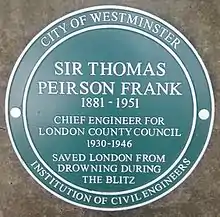Sir Peirson Frank | |
|---|---|
| Born | Thomas Peirson Frank 23 July 1881 |
| Died | 12 November 1951 (aged 70) London, England |
| Nationality | British |
| Occupation | Engineer |
| Engineering career | |
| Discipline | Civil |
| Institutions | Institution of Civil Engineers (president) |
| Projects | Waterloo Bridge; Wandsworth Bridge; Putney Bridge |
Sir Thomas Peirson Frank (23 July 1881 – 12 November 1951) was a British civil engineer and surveyor.[1][2] He is particularly remembered as "the man who saved London from drowning" in the Blitz.[3]

Frank was born in 1881 at Kirkbymoorside, Yorkshire, the son of farmer Thomas Peirson Frank and Jane Shepherd. He was elected to the Smeatonian Society of Civil Engineers in 1937 and was president of the Royal Town Planning Institute in 1944.[4] He was elected president of the Institution of Civil Engineers for the November 1945 to November 1946 session.[5]
Frank was chief engineer of the London County Council from 1931 to 1946 and coordinating officer for Road Repairs and Public Utility Services during the period 1939-1945. He was knighted in 1942 for his direction of the repair services that enabled London to carry on in spite of the severest air raids. He is credited with having organised and put to action "rapid response" teams who repaired upwards of a hundred breaches in the Thames wall, thus preventing low-lying areas of London from being flooded,[6] an achievement that, for reasons of protecting "the public's morale," was kept secret during the war.[6]
On 29 October 2014 a commemorative green plaque, funded by the Institution of Civil Engineers, was unveiled by the Lord Mayor of Westminster in his memory. It is located on a section of the Thames embankment wall, close to the Houses of Parliament, one of the most important locations where Frank organised repairs to bomb damage.[7][8]
References
- ↑ "Obituary: Sir Peirson Frank". The Times. 19 November 1951. p. 8.
- ↑ Entry at National Portrait Gallery
- ↑ "The 'man who saved London from drowning' honoured". UCL Institute of Archaeology. Retrieved 10 July 2015.
- ↑ "Wartime president Sir Thomas Peirson Frank". RTPI. Retrieved 10 July 2015.
- ↑ Watson, Garth (1988). The Civils. Thomas Telford. p. 253. ISBN 0-7277-0392-7.
- 1 2 "Engineer secretly saved London from World War Two floods", BBC News, 30 October 2014
- ↑ "Honor for hero who saved London from WWII flooding". Associated Press. 29 October 2014. Retrieved 10 July 2015.
- ↑ "Sir Thomas Peirson Frank: plaque honours Waterloo Bridge engineer". London SE1 News. 29 October 2014. Retrieved 10 July 2015.